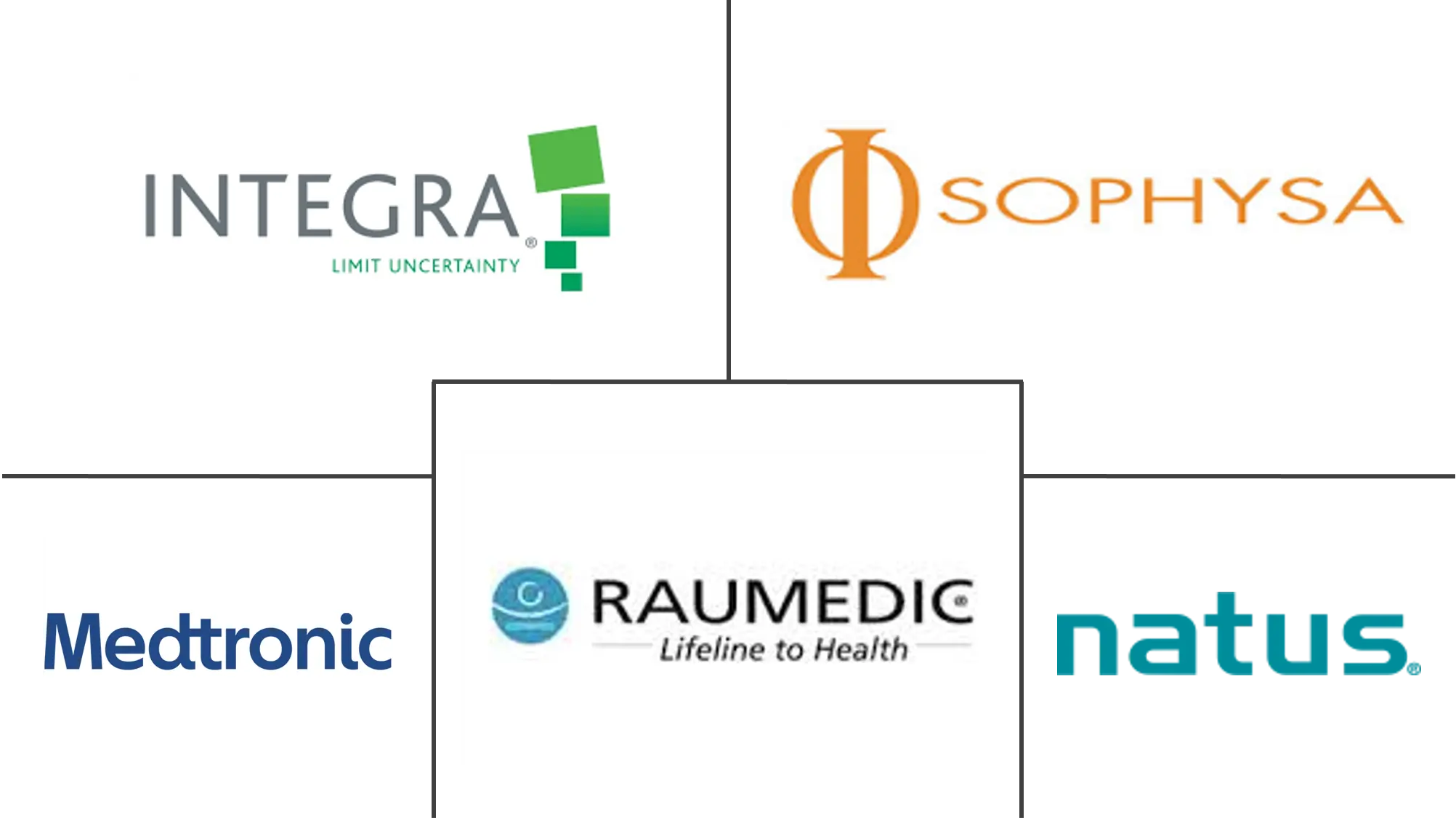Intracranial Pressure Monitoring Market Size and Share
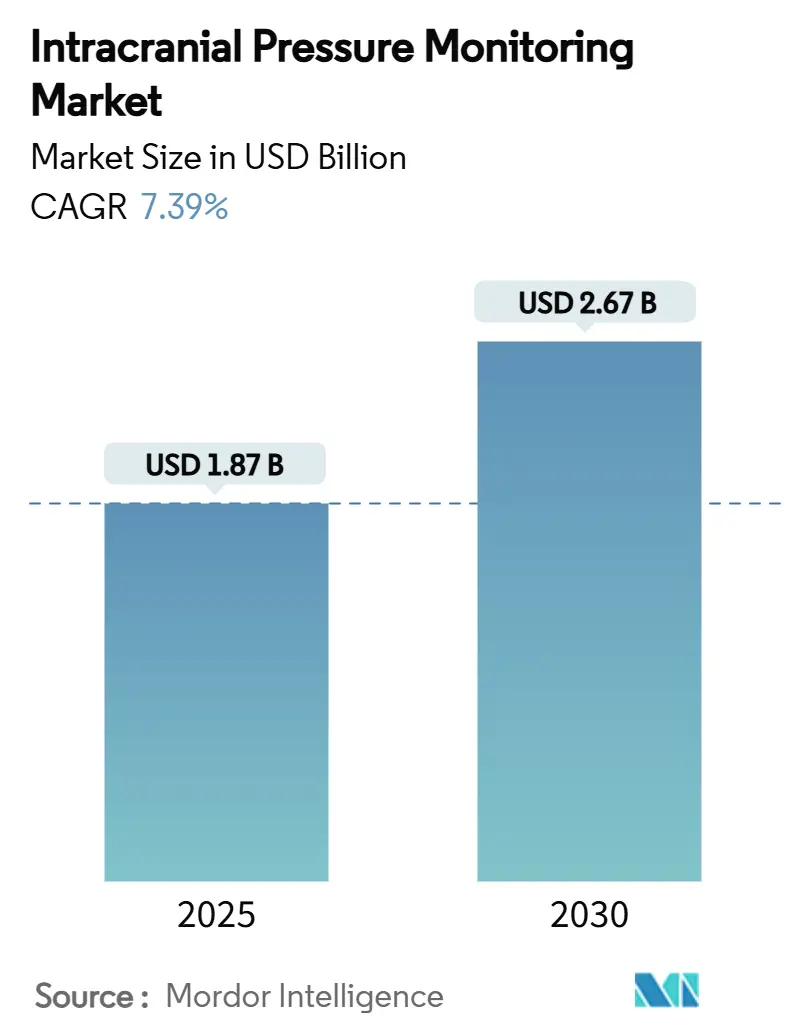
Intracranial Pressure Monitoring Market Analysis by Mordor Intelligence
The intracranial pressure monitoring market stood at USD 1.87 billion in 2025 and is forecast to reach USD 2.67 billion by 2030, advancing at a 7.4% CAGR. Growth rests on the pairing of artificial intelligence with conventional neurocritical care, letting clinicians predict pressure surges well before a patient shows clinical decline.[1]Venkatakrishna Rajajee, “Noninvasive Intracranial Pressure Monitoring: Are We There Yet?” Neurocritical Care, springer.com Hospitals are adopting wireless micro-sensors that deliver accuracy within 1.0 mm Hg of invasive systems, while predictive analytics platforms cut intervention time and lower complication rates. Traumatic brain injury keeps demand steady, but infectious conditions and space medicine add fresh revenue streams. Vendors that integrate cybersecurity, data analytics and biocompatible materials now command premium pricing.
Key Report Takeaways
- By technique, invasive devices held 73.5% of intracranial pressure monitoring market share in 2024, whereas non-invasive systems are on track for a 10.1% CAGR to 2030.
- By application, traumatic brain injury led with 47.6% revenue share in 2024, while meningitis monitoring is projected to grow at 11.2% CAGR through 2030.
- By end-user, hospitals and trauma centres accounted for 51.2% share of the intracranial pressure monitoring market size in 2024; military and space health facilities are expanding at a 9.7% CAGR to 2030.
- By geography, North America dominated with 39.8% share in 2024, yet Asia-Pacific is forecast to post the fastest 9.5% CAGR between 2025 and 2030.
Global Intracranial Pressure Monitoring Market Trends and Insights
Drivers Impact Analysis
| Driver | (~) % Impact on CAGR Forecast | Geographic Relevance | Impact Timeline |
|---|---|---|---|
| Rising Incidence Of Traumatic Brain Injury (TBI) | +1.2% | Global, with highest impact in North America & APAC | Medium term (2-4 years) |
| Growing Prevalence Of Hydrocephalus & Neuro-Degenerative Disorders | +0.9% | Global, concentrated in aging populations of Europe & North America | Long term (≥ 4 years) |
| Rapid Adoption Of Minimally-Invasive Micro-Sensor Technologies | +1.8% | North America & EU leading, APAC following | Short term (≤ 2 years) |
| AI-Driven Personalised ICP Thresholds & Predictive Analytics | +1.5% | North America & EU core, spill-over to APAC | Medium term (2-4 years) |
| Demand From Space-Medicine & High-Altitude Expeditions | +0.3% | North America, EU, with emerging interest in China & India | Long term (≥ 4 years) |
| Paediatric ICU Protocols Mandating Continuous ICP Monitoring | +0.8% | Global, with early adoption in developed markets | Medium term (2-4 years) |
| Source: Mordor Intelligence | |||
Rising Incidence of Traumatic Brain Injury
Traffic collisions, sports mishaps and falls among seniors sustain a high caseload that requires continuous monitoring in intensive care units. Updated Brain Trauma Foundation guidelines recommend pressure tracking for every severe case with a Glasgow Coma Scale below 8, increasing the eligible patient cohort.[2]Nessim Amin and Diana Greene-Chandos, “Intracranial Pressure Monitoring,” Neurocritical Care Monitoring, connect.springerpub.com Military conflicts and adventure sports widen demographic exposure, while value-based care models reward early detection that prevents secondary damage.
Growing Prevalence of Hydrocephalus & Neuro-Degenerative Disorders
Hydrocephalus affects 1 in 1,000 newborns and appears more often among aging adults. Programmable shunt systems now include embedded sensors that fine-tune drainage in real time, trimming revision surgeries.[3]Chenqi He et al., “Intracranial Pressure Monitoring in Neurosurgery: The Present Situation and Prospects,” Chinese Neurosurgical Journal, cnjournal.biomedcentral.com Alzheimer’s and Parkinson’s patients also benefit from sustained monitoring when cerebrospinal dynamics fluctuate.
Rapid Adoption of Minimally Invasive Micro-Sensor Technologies
Next-generation catheters combine pressure, oxygen and temperature sensing through one port, eliminating infection pathways typically seen with external ventricular drains. Wireless variants slash infection rates from 10-15% to near zero and permit patient ambulation. Bioabsorbable versions dissolve post-use, removing the need for extraction.
Demand from Space-Medicine & High-Altitude Expeditions
NASA’s study of spaceflight-associated neuro-ocular syndrome has funded zero-gravity-capable ICP monitors that track fluid shifts during long missions. Portable, non-invasive versions now support mountaineers, soldiers and pilots operating at extreme altitudes where invasive catheters are impractical. China and India are investing in similar technologies for planned lunar and Himalayan missions, accelerating commercial demand. Miniaturised, battery-powered sensors developed for orbit are already migrating into civilian trauma and emergency transport settings, creating downstream market pull.
Restraints Impact Analysis
| Restraint | (~) % Impact on CAGR Forecast | Geographic Relevance | Impact Timeline |
|---|---|---|---|
| High Device & Procedure Cost; Reimbursement Gaps | -1.1% | Global, most pronounced in emerging markets | Short term (≤ 2 years) |
| Shortage Of Trained Neuro-Critical-Care Staff | -0.8% | Global, acute in rural areas and developing countries | Long term (≥ 4 years) |
| Cyber-Security & Data-Privacy Risks With Wireless Systems | -0.5% | North America & EU primarily, expanding globally | Medium term (2-4 years) |
| Supply-Chain Fragility For Sensor-Grade Piezo Materials | -0.7% | Global, concentrated impact on high-tech manufacturing regions | Short term (≤ 2 years) |
| Source: Mordor Intelligence | |||
High Device and Procedure Cost; Reimbursement Gaps
Capital equipment costs range from USD 15,000 to USD 50,000, and each implantation adds another USD 5,000–15,000 in patient charges. Annual maintenance, single-use sensors and software licences inflate lifetime ownership costs. Reimbursement remains patchy; some insurers cover only invasive systems or demand prior authorization, leaving newer non-invasive options unfunded. Hospitals must compile cost–effectiveness dossiers before purchase, so many low-resource centers postpone adoption despite clinical need.
Shortage of Trained Neuro-Critical-Care Staff
Interpreting multiparameter outputs requires six to twelve months of specialised training, yet many regions lack board-certified neurointensivists. General ICU teams often manage complex cranial data with minimal guidance, raising the risk of delayed intervention. Tele-ICU links ease the gap, but bandwidth limits and time-zone lags can slow urgent decisions. Automated alerts help triage cases, yet bedside expertise remains essential, restraining market growth even where hardware is available.
Segment Analysis
By Technique: Invasive Methods Dominate Despite Non-Invasive Innovation
Invasive devices delivered 73.5% of intracranial pressure monitoring market revenue in 2024. External ventricular drains remain indispensable when cerebrospinal fluid diversion is required, while fiber-optic probes offer high fidelity for continuous readings. The segment benefits from standardised clinical protocols and widespread physician familiarity. Non-invasive platforms are growing at 10.1% CAGR, propelled by transcranial Doppler and optic-nerve ultrasonography that achieve clinically acceptable accuracy. Diffuse correlation spectroscopy narrows mean error to 1.0 mm Hg, edging closer to catheter precision.
Continued research funds mobile ultrasound solutions that frontline responders can use before hospital arrival, reinforcing non-invasive momentum. Yet the intracranial pressure monitoring market size for invasive systems is projected to preserve a strong base through 2030 because neurosurgeons still prefer direct readings for complex trauma cases. Hybrid models, where a patient begins with invasive surveillance and shifts to cuff-less optical sensors for step-down care, illustrate convergence across techniques.
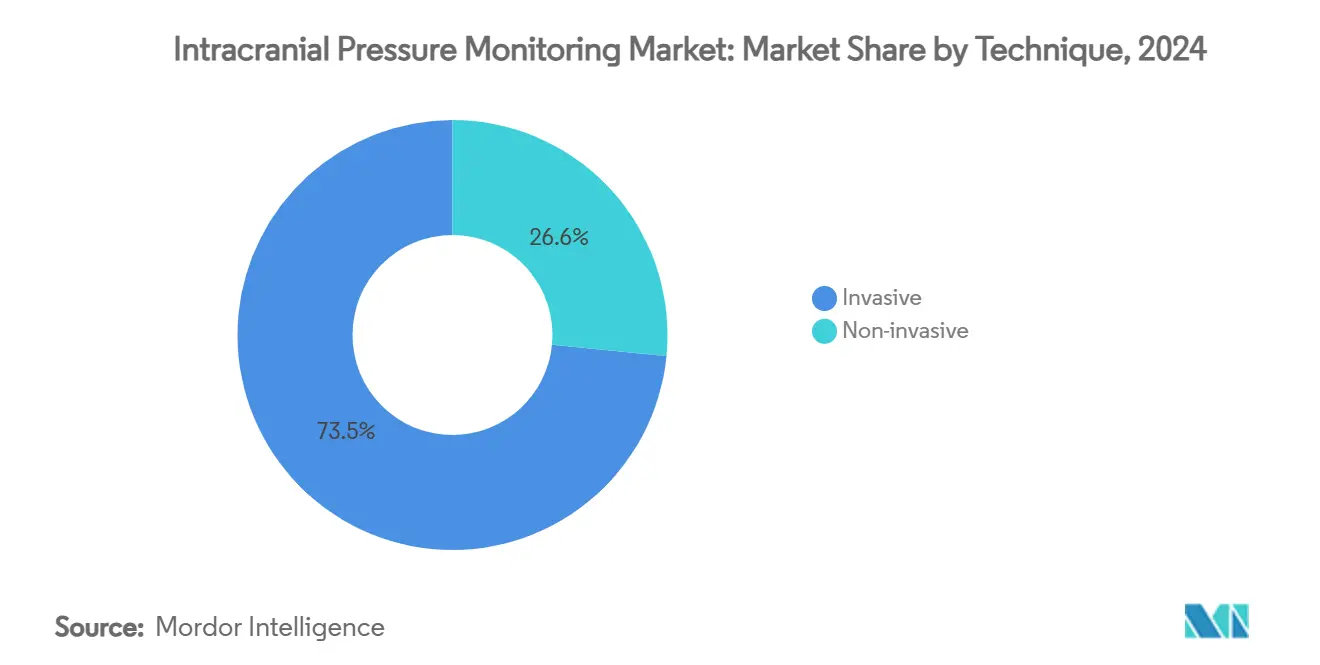
By Application: Meningitis Monitoring Emerges as Growth Driver
Traumatic brain injury represented 47.6% of 2024 revenue, reflecting its entrenched protocol status within intensive care units. TBI cases typically mandate monitoring periods of five to seven days, yielding predictable device utilisation. In contrast, the meningitis segment is scaling at 11.2% CAGR, as clinicians recognise that treating pressure early slashes mortality from 30% to 10% and doubles recovery odds. ICP tracking now guides corticosteroid titration and ventricular drainage decisions during infectious flare-ups.
Hydrocephalus and intracerebral haemorrhage round out the portfolio, each benefitting from sensor-equipped shunts and early warning alerts. The intracranial pressure monitoring market size for meningitis is small today yet has outsized growth potential, particularly in regions where bacterial CNS infections remain prevalent. Advancements in multimodal platforms that combine pressure, oxygen and EEG data provide comprehensive oversight across diverse neurological insults.
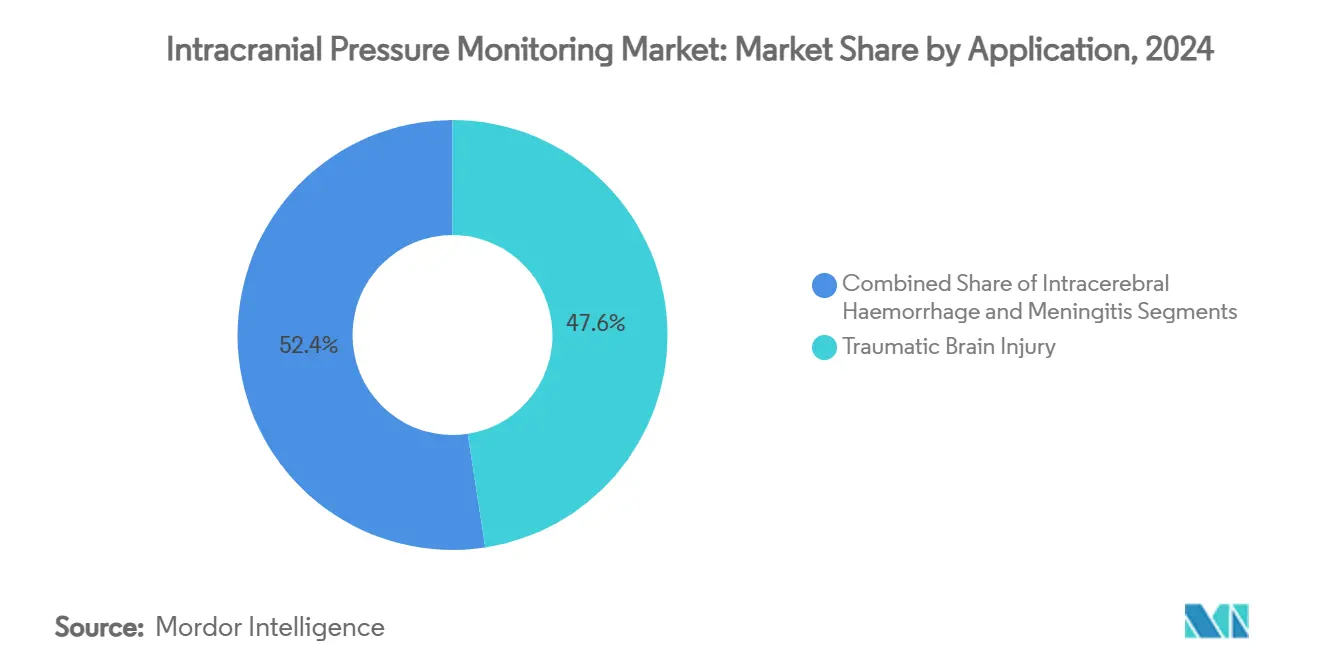
Note: Segment shares of all individual segments available upon report purchase
By End-User: Military and Space Applications Drive Innovation
Hospitals and trauma centres captured 51.2% revenue in 2024 because they possess operating theatres, neurosurgeons and intensive care beds. Continuous monitoring is an expected standard in level-1 trauma institutions, and bundled capital purchases tie sensor demand to renovation cycles. Ambulatory surgical centres are experimenting with short-term postoperative pressure checks, though procedure complexity limits penetration. The military and space health segment is expanding at 9.7% CAGR, reflecting demand from zero-gravity missions, high-altitude deployments and decompression training environments.
Miniaturised, battery-powered implants designed for orbital flight are now transitioning into civilian practice where portability and infection avoidance matter. The intracranial pressure monitoring market share for defence and aerospace remains modest but showcases premium prices and high strategic value. Partnerships between medical device firms and space agencies spur dual-use technology, feeding a virtuous R&D cycle that benefits frontline hospitals.
Geography Analysis
North America held 39.8% of global revenue in 2024 on the back of trauma networks, ample reimbursement and early AI adoption. The United States leads through FDA clearance processes that favour iterative sensor upgrades, while Canada leverages a universal system to implement standardized protocols. Mexico’s device manufacturing clusters add supply resilience, though budget constraints temper hospital uptake. Cyber-security mandates increase compliance costs, yet they also create barriers that protect incumbent vendors.
Asia-Pacific is growing the fastest at 9.5% CAGR thanks to hospital build-outs, rising accident rates and government push for med-tech self-reliance. China subsidises domestic sensor production, and India’s private clinics deploy advanced monitors to serve medical tourists. Japan’s rapidly aging society fuels hydrocephalus applications, whereas South Korea positions trauma facilities as regional centres of excellence. Australia and New Zealand use portable kits to serve mining and remote communities.
Europe shows steady expansion anchored in evidence-based practice and robust data-privacy legislation. Germany and the United Kingdom finance multi-centre trials to validate non-invasive algorithms, while France and Italy refine paediatric protocols. GCC countries invest in neurotrauma capacity, and South Africa pilots tele-neurocritical care to bridge rural gaps. As regulators harmonise rules, market entry becomes simpler yet cyber-security standards tighten, elevating development requirements.
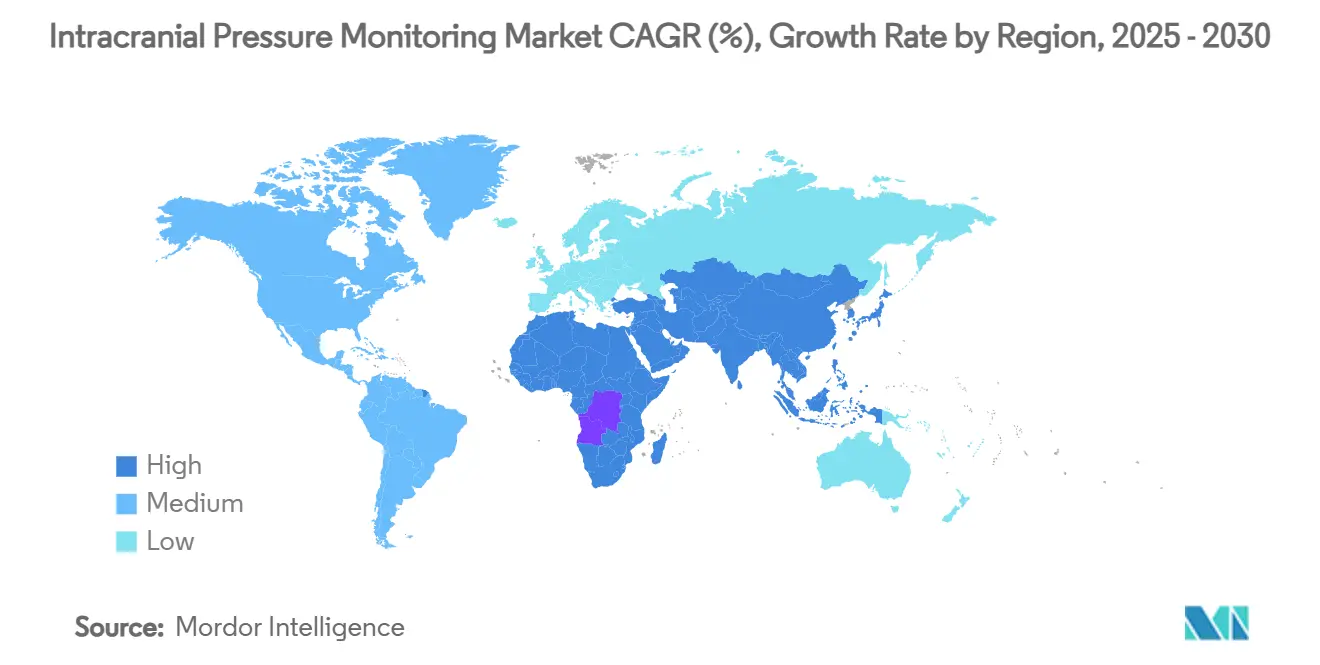
Competitive Landscape
The intracranial pressure monitoring market is moderately fragmented. Medtronic leverages a broad neurosurgical catalogue plus global logistics to hold pole position. Integra LifeSciences targets niche catheters that track oxygen and temperature alongside pressure, appealing to neurointensive units demanding integrated data. Nihon Kohden expanded by acquiring Ad-Tech Medical, pairing EEG platforms with intracranial electrodes to capture long-term epilepsy care.
Younger firms disrupt with diffuse correlation spectroscopy and Doppler-based algorithms that promise catheter-level accuracy without penetration. Wireless, bioabsorbable sensors gain traction as they remove infection concerns and cut operating room time. Cyber-secure firmware becomes a differentiator as hospitals insist on zero-day patching and end-to-end encryption. White-space opportunities span paediatric-specific devices, space-flight solutions and cloud analytics that aggregate signals across entire hospital networks for predictive triage.
Strategic collaborations proliferate. Device makers team with cloud vendors to offer subscription analytics, while aerospace agencies act as test beds for extreme-environment prototypes. Suppliers able to vertically integrate piezo materials hedged against shortages during recent semiconductor disruptions, shielding production schedules.
Intracranial Pressure Monitoring Industry Leaders
-
Medtronic plc
-
RAUMEDIC AG
-
Sophysa Ltd
-
Integra LifeSciences
-
Natus Medical Inc.
- *Disclaimer: Major Players sorted in no particular order
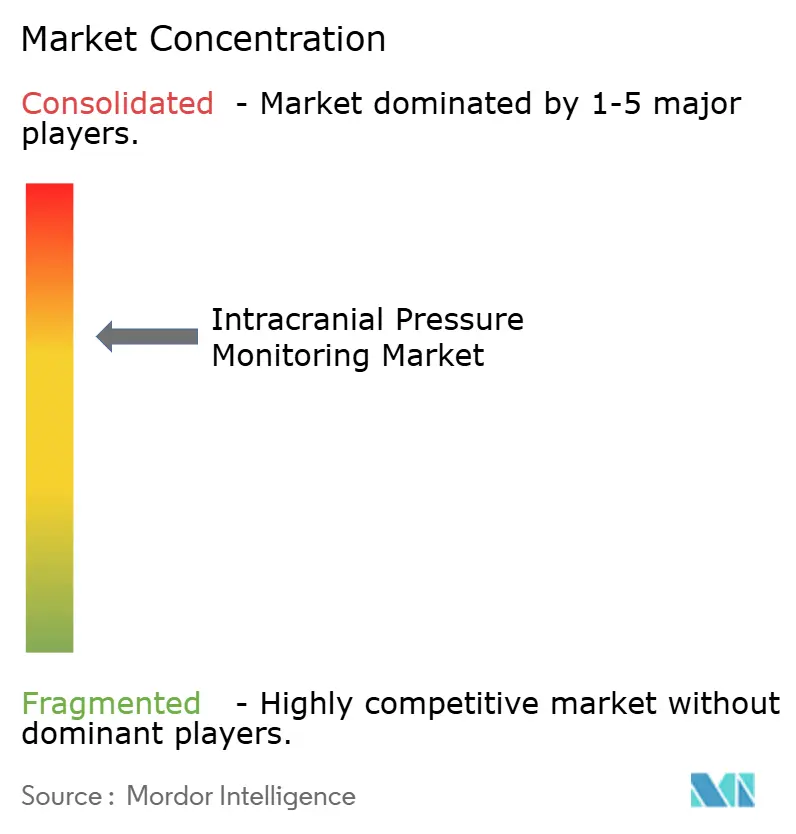
Recent Industry Developments
- March 2025: Anuncia Medical secured FDA Breakthrough Device Designation for ReFlow EVD, a system that enables at-home cerebrospinal fluid maintenance and promises fewer revision surgeries.
- November 2024: Nihon Kohden bought a 71.4% stake in NeuroAdvanced, parent of Ad-Tech Medical, strengthening its neurological portfolio through specialised intracranial electrodes.
Global Intracranial Pressure Monitoring Market Report Scope
Intracranial pressure (ICP) monitoring is used by doctors to identify whether symptoms of high pressure in the head are being brought on by high or low cerebrospinal fluid (CSF) pressure.
The Intracranial Pressure Monitoring Market is Segmented by Technique (Invasive and Non-invasive), Application (Traumatic Brain Injury, Intracerebral Hemorrhage, Meningitis, and Other Applications), and Geography (North America, Europe, Asia-Pacific, Middle-East and Africa, and South America). The report also covers the estimated market sizes and trends for 17 countries across major regions globally. The report offers the value (in USD million) for the above segments.
| Invasive | External Ventricular Drainage (EVD) |
| Micro-transducer ICP Monitoring | |
| Non-invasive | Transcranial Doppler Ultrasonography |
| Tympanic Membrane Displacement | |
| Optic Nerve Sheath Diameter | |
| MRI / CT-based ICP Estimation | |
| Other Non-invasive Techniques |
| Traumatic Brain Injury |
| Intracerebral Haemorrhage |
| Meningitis |
| Other Applications |
| Hospitals & Trauma Centres |
| Neuro-intensive Care Units (NICUs) |
| Ambulatory Surgical Centres |
| Military & Space Health Facilities |
| North America | United States |
| Canada | |
| Mexico | |
| Europe | Germany |
| United Kingdom | |
| France | |
| Italy | |
| Spain | |
| Rest of Europe | |
| Asia-Pacific | China |
| Japan | |
| India | |
| Australia | |
| South Korea | |
| Rest of Asia-Pacific | |
| Middle East and Africa | GCC |
| South Africa | |
| Rest of Middle East and Africa | |
| South America | Brazil |
| Argentina | |
| Rest of South America |
| By Technique | Invasive | External Ventricular Drainage (EVD) |
| Micro-transducer ICP Monitoring | ||
| Non-invasive | Transcranial Doppler Ultrasonography | |
| Tympanic Membrane Displacement | ||
| Optic Nerve Sheath Diameter | ||
| MRI / CT-based ICP Estimation | ||
| Other Non-invasive Techniques | ||
| By Application | Traumatic Brain Injury | |
| Intracerebral Haemorrhage | ||
| Meningitis | ||
| Other Applications | ||
| By End-User | Hospitals & Trauma Centres | |
| Neuro-intensive Care Units (NICUs) | ||
| Ambulatory Surgical Centres | ||
| Military & Space Health Facilities | ||
| By Geography | North America | United States |
| Canada | ||
| Mexico | ||
| Europe | Germany | |
| United Kingdom | ||
| France | ||
| Italy | ||
| Spain | ||
| Rest of Europe | ||
| Asia-Pacific | China | |
| Japan | ||
| India | ||
| Australia | ||
| South Korea | ||
| Rest of Asia-Pacific | ||
| Middle East and Africa | GCC | |
| South Africa | ||
| Rest of Middle East and Africa | ||
| South America | Brazil | |
| Argentina | ||
| Rest of South America | ||
Key Questions Answered in the Report
1. What is the current size of the intracranial pressure monitoring market?
The market generated USD 1.87 billion in 2025 and is projected to hit USD 2.67 billion by 2030.
2. Which technique leads global revenue?
Invasive systems such as external ventricular drains held 73.5% of intracranial pressure monitoring market share in 2024.
3. What application segment is growing fastest?
Meningitis monitoring shows the highest growth, with an 11.2% CAGR expected through 2030.
4. Why is Asia-Pacific the fastest-growing region?
Large-scale hospital construction, rising trauma cases and government support for local med-tech production drive the region’s 9.5% CAGR.
5. How are AI and predictive analytics changing ICP care?
Machine-learning models now forecast pressure spikes up to an hour in advance with about 90% accuracy, enabling proactive treatment and better outcomes.
6. What is the main restraint limiting adoption?
High device and procedure costs, coupled with uneven reimbursement policies, reduce access in many emerging markets.
Page last updated on:
